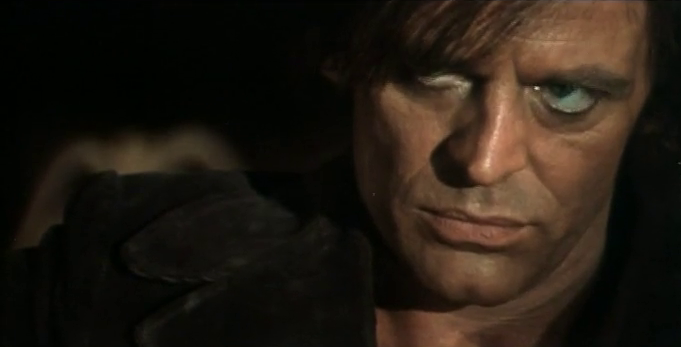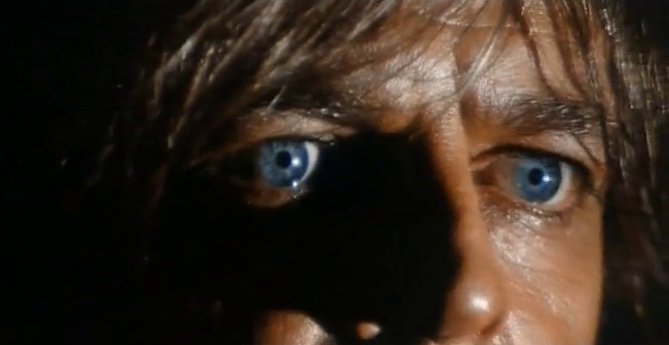Dir: Antonio Margheriti (as Anthony Dawson)
Star: Klaus Kinski, Peter Carsten, Marcella Michelangeli, Antonio Cantafora
Of all the many spaghetti Westerns in which Kinski was involved, this likely deserves to be considered as among the very best. For a Few Dollars More and The Great Silence are perhaps better overall, but that’s including the non-Klaus elements like cinematography and music. For pure, undiluted Kinski, this is probably the best, and it’s notable for going against type. Klaus is the hero. Yes, that is not a typo. He plays a good guy, not a deceitful snake. Sure, he’s still a grim and remorseless killer. But he’s a grim and remorseless killer for a reason, and in the Western genre, that makes all the difference between sporting a black hat and a white one.
He plays Gary Hamilton, who was unjustly sentenced to hard labor for reasons we eventually discover, and has spent the last decade breaking rocks, before receiving entirely unexpected clemency, due to his previous honorable service in the military. Immediately on release, Gary sets about taking revenge on the man responsible for putting him behind bars, Acombar (Karsten), who is now enjoying a very pleasant life, and the fruits of his ill-gotten gains. Not the least of which is Gary’s woman, Maria (Michelangeli), who switched sides to become Acombar’s moll. He’s less than pleased to hear Gary is out, and dispatches his minions (including Gina Lollobrigida’s cousin, Guido) to ensure the disgruntled ex-prisoner doesn’t even reach Acombar’s ranch.
The above all takes place within the first 25 minutes, with the remaining 70 largely devoted to Gary’s assault. The town is under a tornado warning, meaning the streets are deserted as the storm swirls around, except for our hero and Acombar’s man. But Gary has a big advantage, in that he was brought up in the town, and knows it like the back of his hand. This includes the network of tunnels running underneath it, which he uses to outflank and sneak up on the hapless opponents. His war is as much a psychological one as physical, for example, ringing to church bell to lure in the enemy. He does this not once, but twice – only, on the second occasion, one of their number is dangling at the end of the bell-rope. He then sets up another to be crushed by the giant bell.

It’s established early on he’s a crack-shot, and is supremely confident in his own abilities. By coincidence, he arrives in town on the same stage as Acombar’s son, Dick (Cantafora), who is entirely unaware of the source of his family wealth, and quite deliberately gives up the element of surprise. “You tell your father, Gary Hamilton’s back in town,” he says, adding even more ominously, “And I’ll see him at sundown.” Again, this is part of his psychological approach, knowing this will force Acombar into action. Perhaps a wiser tactic would have been to shore up his defense, and hunker down to wait for Gary’s arrival, rather than going out to meet on his terms and turf.
It does definitely take a little bit of getting used to seeing Klaus in a “heroic” role. Though, as noted above, it’s perhaps closer to an anti-hero, given Gary clearly has no aversion to spilling blood, and is entirely and single-mindedly focused on making Acombar pay. This is a man on a mission, not interested in chat, and impossible to dissuade. You might as well try and talk the tornado out of its destructive path. And by the time the end credits roll, that vengeance is utterly complete. His target has lost everything that matters: the respect of his son, his woman, all his men, his ranch and, only then, his life. Yeah, that’s technically a spoiler. But did you really expect it to end in any other way?
There are apparently strong similarities between this and 1968’s A Stranger in Paso Bravo, in which a man, unjustly imprisoned is released to seek revenge on those responsible. Now, that’s hardly a new story, and you could write this off as parallel development. Except for the hero’s name in Stranger being… Gary Hamilton, with the antagonist called Acombar. Hmm. The two films have different scriptwriters, but the coincidences are just too much to overlook. I have not seen Stranger, but those who have universally say that Cain is the superior adaptation. So while I’m in no rush to see what will likely seem like a poor knock-off, it is something which should likely be acknowledged.

Margheriti turned his hand to just about every genre over his forty-year career as a director. But in the first of his four times working with Kinski, it’s perhaps his horror experience which comes through most. That dates back to 1964’s black and white Castle of Blood, later remade in color with Kinski as Web of the Spider. A dark and stormy setting (even if the day-for-night photography sometimes isn’t too successful), plus an unstoppable killing machine, perhaps makes this an ancestor of Halloween – if Michael Myers were the good guy. There’s certainly no shortage of impressive visual style, up to the rather contrived “hall of mirrors” finale between Hamilton and Acombar. This was likely inspired by Orson Welles’ The Lady From Shanghai, though in my personal lexicon of cinema, it felt more like the final showdown in Enter the Dragon.
I’ve read a couple of pieces suggesting Gary is actually a ghost – he died in prison, and it’s his vengeful spirit, which returns to seek out and destroy Acombar. It’s an interesting thought, but does seem at odds with an early scene in the quarry where he and his fellow inmates are laboring. He kills a rattlesnake, despite being informed, “There’s one way out of this place.” “That’s not the way I want to go,” replies Hamilton, which seems less like a specter, and more like a man intent on clinging on to life, at least until he has achieved his revenge. #LifeGoals, I guess. I’m also a bit confused by the title, referring to the Biblical story in which Cain murdered his brother, Abel in an unjustified fit of rage. Hard to think of anything less like what we have here. Still, that doesn’t stop it from being one of Kinski’s absolute best.

